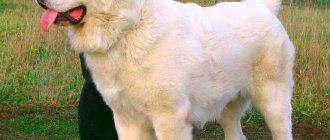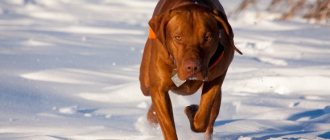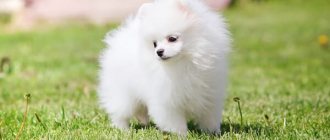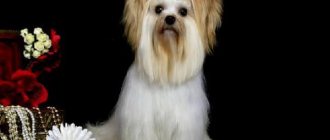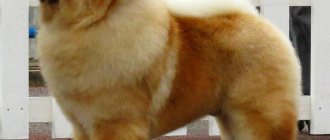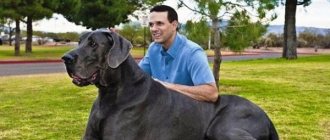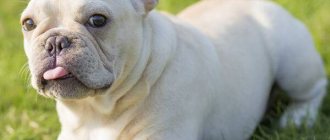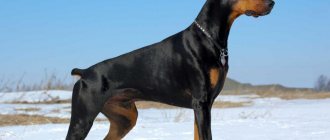Ibizan Greyhound
- Region of origin: Balearic Islands
- Approximate date: 3000 BC. e.
With the grace of a deer and a long, lean build, Ibizans may share common roots with the Pharaoh Hound. In appearance, they resemble dogs depicted on tombs in Ancient Egypt dating back to the third millennium BC.
Bred to hunt small game, especially rabbits, the Ibizan Hound was kept purebred to preserve its incredibly keen sense of smell and hearing. Considered a rare breed by today's standards, Ibizans were officially recognized by the dog breed almost half a century ago.
Chow chow
Thanks to their thick fluffy fur and funny elongated tongue, these pets resemble teddy bears. But in reality they are much stronger and stronger than they seem at first glance.
The ancestors of modern Chow Chows were once used to guard ancient temples and for hunting. They can be cruel when it comes to protecting their owners from any external threats.
Shiba Inu
- Region of origin: Japan
- Approximate date: 300 BC. e.
DNA analysis shows that the Shiba Inu is one of the oldest Asian dog breeds, dating back to the 3rd century BC. This small, agile dog copes well with overcoming the obstacles of the mountain landscape. It was originally bred to hunt game. The Shiba Inu is similar to and is often mistaken for other Japanese hunting dogs such as the Hokkaido and Akita Inu, although it has a different disposition and is more compact in size.
This is one of the few ancient dog breeds that still exist in the world. The breed almost went extinct during World War II and is still rare today. The Shiba Inu was brought to the Russian Federation only at the end of the 20th century.
Alaskan Malamute
The Alaskan Malamute is a Scandinavian sled dog named after the Alaskan tribe that raised the dogs. The breed is descended from the Arctic wolf, and was originally used to pull sleds.
Like Samoyeds, these dogs also participated in polar expeditions, including Admiral Byrd's exploration of the South Pole. The Alaskan Malamute is related to three other Arctic breeds, including Siberian Huskies, Samoyeds and American Eskimo dogs.
Lhasa apso
- Region of origin: Tibet
- Approximate date: 800 BC. e.
The Lhasa Apso is originally from Tibet. The breed was bred by Buddhist monks as a guardian who warned the monks of any intruders. The capital of Tibet is “Lhasa” and “apso” is a Tibetan word meaning “bearded”. Hence, "Lhasa Apso" translates to "bearded dog from Tibet." However, another version is also widespread. Many believe that the word "apso" is a reference to the Tibetan word "rapso", meaning "goat". The Lhasa Aspo probably guarded timid Tibetan domestic goats. The Lhasa Apso first appeared in Europe at the beginning of the 20th century.
Alabai: description, breeding
The breed was formed over 4000 years, and the blood of shepherd, fighting, and nomadic dogs flows in its veins. During the formation of the breed, the dogs went through cruel natural selection: harsh climatic living conditions, protection of homes and livestock, hard physical labor and the fight against predators - all this strengthened their character and gave them the appearance and endurance that we know now.
The standard for this ancient dog breed was adopted only in 1993; mitigating changes were made in 2000 and 2010. Today the following standard applies:
- The dimensions of a male at the withers are at least 70 cm, for females - at least 65 cm.
- Weight - from 40 to 80 kg.
- The physique is powerful, the paws are strong, widely spaced, the chest is wide, the belly is tucked, and the rear is high.
- Working qualities - protection and security.
Today, many people get an Alabai as a companion, and this dog is perfect for this role. Easy to train, friendly to children and other animals.
Alabais are bred in many cities of Russia, so it is not difficult to buy a high-breed puppy.
Peruvian hairless dog
- Region of origin: Peru
- Approximate date: 300 BC. e.
The breed is first depicted on ancient pottery dating back to 750 AD. But the Peruvian Hairless Dog appeared long before that. It was maintained by the Inca tribes and their descendants, the Quechua. The breed comes in two varieties: hairless or sparsely haired. Wool comes in different colors.
Loyal, vigilant and energetic, the Peruvian Inca Orchid requires a lot of daily activity to stay healthy and happy. Socialization from an early age is also important. Due to their hunting instincts, this breed may not get along well with small animals.
The story of man's four-legged friend
Today there are at least two theories about the origin of the first Canis lupus familiaris. According to one version, its ancestors were wolves, according to another - jackals. Researchers could not come to a common point of view on the issue of the number of ancestors. Thus, some scientists insist that the very first Canis lupus familiaris is a result that descended from several ancestors (that is, a polyphyletic theory of origin). Other scientists consider the monophyletic theory, according to which an ordinary dog has one ancestor, to be correct.
It's difficult to say which theory is correct. But if you look at the breeds of canines and analyze their exterior and internal qualities, you can see several ancestors (not only the wolf, but also certain types of jackals).
But after being thoroughly analyzed:
- chromosomes;
- behavioral habits;
- morphology;
- vocalization;
- molecular genetic connections are determined by only one ancestor - the wolf.
Saluki
- Region of origin: Middle East
- Approximate date: 3500 BC. uh
Evidence of the Saluki can be traced back to the Early Kingdom of ancient Egypt, where they were used by nomads to catch foxes, ibex, hares and gazelles in the desert. This graceful and fast Persian hound is famous for its endurance and strength, which allowed it to hunt in sandy or rocky areas.
Shaped like a typical greyhound, they come in two varieties: smooth and feathered. Although they are an independent breed that requires patient training, they are gentle and affectionate with their owners. Salukis are sensitive, calm, gentle and devoted to their family members. Due to their strong hunting instincts, they often chase small animals and like to run quickly across open spaces.
Pekingese
Now everyone knows the Pekingese, but in ancient times this breed of dog was available only to aristocrats. In Ancient China, it was believed that these animals combined the characters of a proud monkey and a brave lion. Therefore, attempts to steal a Pekingese 2 thousand years ago were punishable by death.
The presence of hunting skills, endurance and courageous character do not fit in with the ancient breed, given the miniature physique of its individuals. This is a rare case when short stature is an advantage of an animal.
Greyhound
- Region of origin: UK
- Approximate date: 600 BC. uh
This ancient breed, similar to the greyhounds depicted in art from Greek, Egyptian and Roman times, also became popular among English nobility and commoners. Known for their ability to run quickly and catch game with agility, greyhounds became sought after for hunting rabbits and foxes in the 1800s and then began competing as hound dogs in America in the 1900s.
English greyhounds are sensitive, independent and calm. They get along well with other pets and dogs they grew up with.
Basenji
The Basenji
is believed to be one of the oldest domesticated dogs. Its reputation as a dog that does not bark may be due to the fact that ancient people preferred a quiet dog as a hunter. Basenjis bark, but usually only once and then remain silent.
Another interesting aspect of this breed is that it can only be partially domesticated. The Basenji's metabolism is different from that of any other domesticated dog, with females having only one cycle per year compared to other domesticated dogs which have two cycles per year.
Basenjis were used by African tribes to play, carry objects, and warn of possible dangers. The American Kennel Club recognized this breed in 1943.
Home life eliminates wildness
Today, the dog is considered one of the very first animals that was domesticated by humans. Researchers agree that the first domestic dog appeared during the Upper Paleolithic period in the Old World (present-day Europe). True, representatives of the scientific world are not 100% sure about domestication, the exact time, and the reason that prompted man to tame the first dog.
The main witnesses to the history of domestication were rock paintings found by archaeologists. According to primitive drawings, the very first Canis lupus familiaris had:
- big sizes;
- powerful jaws;
- huge paws.
Xoloitzcuintle
The Mexican Hairless is considered the very first breed of dog in the world. There is no exact version of the origin of this species, but it is known that the Xoloitzcuintle appeared approximately several thousand years ago in Central America and Mexico. These individuals were faithful companions of the Indians of many tribes, who considered them sacred animals.
Note: in times of famine, dogs could be used as food.
The peculiarity of the Xoloitzcuintle is their character. These dogs tend to consider one person as their owner, but they also treat other family members with trepidation. Mexican Hairless are unsurpassed guards, able to anticipate the appearance of uninvited guests long before their arrival. This, by the way, determines the myths according to which the described breed is prone to displaying supernatural abilities.
The fairy tale is a lie, but there is a hint in it
There is a legend according to which primitive man, who was already different from his ape relatives, living in the African savannah, was daily at risk of attack by wild animals. Despite the fact that he already had his first weapon in the form of a stone axe, it did not always save him from a suddenly attacking wild beast. In addition, a person had to get food (preferably meat) and sometimes sleep, that is, expose himself to additional danger. But just like in a Hollywood blockbuster, help came from a completely unexpected direction. A dog, or rather its ancestor, saved primitive man from the complexities and difficulties of existence.
From the first days of its existence, such a tandem turned out to be very harmonious, because both people and their new friends had similar requirements in their habitat. It’s hard to say what the first meeting of a two-legged creature and its four-legged companion was, but it’s unlikely to be calm and peaceful. But after a very short period, they defended their home together and went out hunting for wild animals. Evil and aggressive dogs that tried to dominate a person were simply kicked out of the family or destroyed by the latter. Well, those representatives of the canines who remained, in the process of evolution, became more and more tolerant of humans and eventually recognized his superiority over themselves. Until primitive man led a nomadic life, his companion also belonged to the nomadic animals. But after people settled in one area and acquired housing, the dog became a pet.
The difference between a wild animal and a domestic one was obvious. The domestic dog treated the person as an owner, and not as a threat from which he needed to run away or defend himself. Pets not only became more docile and loyal, but also even changed in appearance. So a modern dog differs by 60, or even 70 percent, from the first one, which received the definition of “domestic”.
Man took an active part in improving his pet and, as a result of this painstaking and long-term work, he bred for himself a variety of breeds and types of dogs, each of which met certain requirements and had certain qualities.
So a person who, in addition to hunting, began to develop cattle breeding and agriculture, developed unique breeds that helped protect livestock and even transport people. Some dogs were created to save, while others, on the contrary, had the killer instinct cultivated. It is unlikely that our ancestors, who tamed the first dog, could have thought that an animal would appear that would be combed in special salons and dressed in outfits. But lap dogs occupy one of the leading places in the world today in terms of popularity and prevalence. But no matter what the dog is - big or small, strong or simply beautiful, without it a person’s life would have turned out completely differently and hardly so successfully.
Where?
In the already mentioned work [], the Ural-Himalaya line is taken as the border between the western and eastern parts of Eurasia. Behind it, dogs have the greatest genetic diversity, and 88% of dogs are classified into the characteristic eastern clades A and B. Further development of the hypothesis of the eastern origin of dogs was proposed by large research groups. One of them localized the focus of domestication in the region south of the river. Yangtze and considered it the only one for all dogs []. The most ancient find, according to the authors, dates back to 7.1 thousand years, and genetic calculations place the time of the appearance of dogs in a vague framework of 16.3–5.4 thousand years.
According to more complete data, in the provinces of Southeast China (mainly the basin of the middle and lower reaches of the Yangtze River), the earliest dogs are dated in the range of 7.4–4.2 thousand years. Only in Zhenjiang province are they older - up to 8.2–7.0 thousand years. The maximum dating of finds in the Eastern and North-Eastern regions is close to them. In the Central and Western regions they reach up to 9 thousand years []. In Northern China, the remains of a dog are dated to about 10 thousand years ago, but bone measurements have not been published [].

